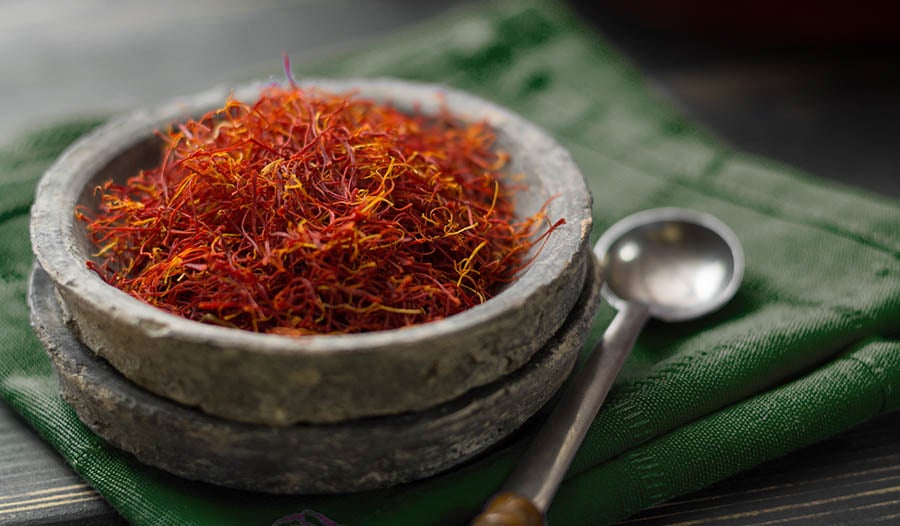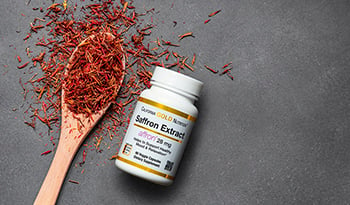Saffron: A Natural Approach to Supporting Neuropsychiatric Health
DISCLAIMER:This blog does not intend to provide diagnosis...
- In this article:
- Saffron and Treatment of Many Neuropsychiatric Disorders
- Saffron and Depressed Mood
- Saffron and ADHD
- Saffron and Alzheimer’s Disease
- Saffron, Anxiety, Schizophrenia and Obsessive-Compulsive Disorder
- Saffron, Antioxidants and Neuroprotective Properties

Limitations of available mainstream treatments invite evidence-based complementary and alternative (CAM) treatments.
Limited effectiveness, safety problems, and high costs of many psychotropic medications have resulted in an urgent mandate for safer, more effective and more affordable treatments of mental illness. After decades of research and billions of dollars of industry funding, the evidence supporting widely used pharmacologic treatments of major depressive disorder, bipolar disorder, schizophrenia, and other psychiatric disorders is not compelling. These issues have led increasing numbers of individuals with mental health problems to seek treatment from complementary and alternative medical (CAM) practitioners, including Chinese medical practitioners, naturopathic doctors, herbalists, chiropractors, homeopathic physicians and others. In the context of growing interest in integrative mental health care, saffron is emerging as a promising approach for a variety of neuropsychiatric disorders.
Saffron and Treatment of Many Neuropsychiatric Disorders
Saffron (Crocus sativus) has a long history of traditional use in Persian and Chinese medicine for its aphrodisiac, expectorant, antispasmodic, antiseptic, and cognitive enhancing effects. Accumulating research findings from human studies support that saffron has shown beneficial effects in a depressed mood, Alzheimer’s disease and attention-deficit hyperactivity disorder (ADHD). Findings from animal studies suggest that saffron may also have beneficial effects in individuals diagnosed with anxiety disorders, schizophrenia and obsessive-compulsive disorder (OCD). The bioactive constituents of saffron may increase reuptake inhibition of dopamine and norepinephrine and may function as both N-methyl D-aspartic acid (NMDA) receptor antagonists and GABA-agonists. The balance of this short article is offered as a concise review of research findings on saffron in a depressed mood, Alzheimer’s disease (AD), attention-deficit hyperactivity disorder (ADHD).
Saffron and Depressed Mood
The antidepressant benefits of saffron may be due to multiple mechanisms including its serotonergic, antioxidant, anti-inflammatory, neuroendocrine and neuroprotective effects. A systematic review of 6 placebo-controlled studies on saffron in mild to moderate depressed mood concluded that saffron and antidepressants have comparable efficacy. A 2019 meta-analysis that included 11 placebo-controlled studies (Total N >500) on saffron in individuals with mild to moderate depressed mood concluded that saffron was statistically significantly superior to placebo and had equivalent efficacy to SSRI antidepressants (fluoxetine, citalopram). There were no differences in the incidence of adverse effects in response to saffron vs placebo, even in studies where high doses of saffron were used (up to 1.5 mg/day). All studies included in the meta-analysis were conducted in Iran where saffron is traditionally used to treat depressed mood and a variety of medical conditions. Further, many patients had medical comorbidities. Both factors that may have biased outcomes. Large placebo-controlled trials by independent research groups are needed to confirm these findings and to determine the optimal dosage and duration of treatment. Emerging findings suggest that curcumin (from Turmeric) has antidepressant effects both as a monotherapy and as an adjunct to antidepressants. It has been suggested that combining curcumin and saffron may result in synergistic antidepressant benefits. In a 12-week double-blind placebo-controlled study, individuals diagnosed with major depressive disorder randomized to a low-dose curcumin extract (250mg BID), high dose curcumin extract (500mg BID) or combined low-dose curcumin plus saffron (15mg BID) experienced comparable and significant improvement in mood compared to placebo. More studies are needed to determine whether different dosages of these herbal products yield differential antidepressant responses.
Cultivation and harvesting of C. Sativus is labor intensive requiring hundreds of hours of hand-picking of the stigmas from thousands of flowers. A consequence is a high cost and limited availability of quality saffron on the world market. In efforts to find a higher yielding, less expensive source of C. Sativus, researchers extracted several active constituents from the corms of C. Sativus and investigated their effects on a behavioral model of depressed mood in mice. The researchers identified two bioactive fractions that may have antidepressant efficacy equivalent to saffron derived from stigmas. Placebo-controlled clinical trials are needed to confirm this finding in depressed humans.
Saffron and ADHD
Stimulants such as methylphenidate and others widely used to treat ADHD cause adverse effects such as insomnia, decreased appetite and abdominal pain. Stimulants and other pharmacologic treatments of adulthood ADHD may be only half as effective as they are in children. Widely shared concerns over these issues have led to studies on promising natural products and other complementary and alternative (CAM) modalities.
The bioactive constituents of saffron may increase reuptake inhibition of dopamine and norepinephrine and may function as both N-methyl D-aspartic acid (NMDA) receptor antagonists and GABA-a agonists. Both mechanisms are believed to mediate beneficial effects on symptoms of inattention. Findings of a 6-week randomized double-blind study on children and adolescents diagnosed with ADHD showed equivalent efficacy of saffron (20 to 30mg/day) and methylphenidate (20 to 30mg/d) on parent and teacher symptom rating scales. This finding should be regarded as preliminary pending confirmation by a large, long-term placebo-controlled study.
Saffron and Alzheimer’s Disease
Emerging research findings are substantiating long-standing claims from traditional medicine that saffron improves cognitive functioning in healthy individuals and may reduce symptoms of cognitive impairment in Alzheimer’s disease (AD). The cognitive enhancing effects of saffron are believed to be mediated by both antioxidant and anti-amyloidogenic activity. Findings of placebo-controlled studies on saffron in AD report consistent cognitive benefits. In a 22-week placebo-controlled trial 55 individuals with mild to moderate AD randomized to saffron (15mg twice daily) vs donepezil (5mg twice daily), a widely prescribed cholinesterase inhibitor, showed equivalent improvement in measures of behavior and cognitive functioning based on standardized symptom rating scales. The high rate of comorbidity of depressed mood in AD makes saffron a reasonable choice in this population.
Saffron, Anxiety, Schizophrenia and Obsessive-Compulsive Disorder
In addition to its beneficial effects in depressed mood, Alzheimer’s disease and ADHD, emerging findings from animal studies suggest that saffron may have beneficial effects on symptoms of anxiety and psychosis and obsessive-compulsive disorder (OCD). However, to date human clinical trials have not investigated the efficacy of saffron in any of these disorders. The mechanism or mechanisms by which the bioactive components of saffron mediate anti-anxiety, antipsychotic and anti-obsessional effects have not been elucidated but may involve modulation of both the GABA-A and NMDA neurotransmitter systems.
Saffron, Antioxidants and Neuroprotective Properties
The limitations of available conventional treatments of mental health problems are stimulating research on a range of complementary and alternative (CAM) treatments. Among other nonpharmacologic modalities, interest in saffron as a treatment of neuropsychiatric disorders has increased in recent years. Research findings support that saffron has significant antioxidant and neuroprotective effects and is a safe and effective treatment of mild to moderate depressed mood, and mild to moderate Alzheimer’s disease. A recent study suggests that saffron has comparable efficacy to stimulant medication in the treatment of ADHD. Preliminary findings from preclinical animal studies suggest that saffron may have significant anti-anxiety, antipsychotic and anti-obsessional efficacy. Large, long-term placebo-controlled studies are needed to confirm the above findings and determine optimal dosing strategies, and investigate safe appropriate uses of saffron in combination with other natural products and psychotropic medications.
References:
- Akhondzadeh Basti A, Moshiri E, Noorbala A-A, Jamshidi A-H, Abbasi SH, Akhondzadeh S: Comparison of petal of Crocus sativus L. and fluoxetine in the treatment of depressed outpatients: A pilot double-blind randomized trial. Prog Neuropsychopharmacol Biol Psychiatry 31:439–442, 2007.
- Akhondzadeh S, Shafiee Sabet M, Harirchian MH, Togha M, Cheraghmakani H, Razeghi S, Hejazi SS, Yousefi MH, Alimardani R, Jamshidi AH, Zare F, Moradi A (2009) Saffron in the treatment of patients with mild to moderate Alzheimer’s disease: a 16-week, randomized and placebo controlled trial. J Clin Pharm Ther
- Akhondzadeh, S. et al, A22-week, multicenter, randomized, double-blind controlled trial of Crocus sativus in the treatment of mild-to-moderate Alzheimer’s disease, Psychopharmacology (2010) 207:637–643
- Barnes PM, Bloom B, Nahin RL. Complementary and alternative medicine use among adults and children: United States, 2007. Natl Health Stat Report 2008 Dec 10;(12):1-23.
- Baziar, S., Aqamolaei, A., Khadem, E., Mortazavi, S., Naderi, S. et al (2019) Crocus sativus L. Versus Methylphenidate in Treatment of Children with Attention-Deficit/Hyperactivity Disorder: A Randomized, Double-Blind Pilot Study. J Child Adolesc Psychopharmacol. 29:3; 1-8.
- Berman SM, et al. Potential adverse effects of amphetamine treatment on brain and behavior: a review. Mol Psychiatry. 2009;14(2):123–42.
- Denys, D., de Haan, L., (2008) [25 years antipsychotics: back to the future?] [Article in Dutch] Tijdschr Psychiatr. 2008;50 Spec no.:105-9.
- Fernandez JA (2004) Biology, biotechnology and biomedicine of saffron. Recent Res Dev Plant Sci 2:127–159.
- Fournier JC, DeRubeis RJ, Hollon SD, et al. Antidepressant drug effects and depression severity: A patient-level meta-analysis. JAMA 2010 Jan 6;303(1):47-53.
- Georgiadou G, Tarantilis PA, Pitsikas N. Effects of the active constituents of Crocus Sativus L., crocins, in an animal model of obsessive-compulsive disorder. Neurosci Lett. 2012 Oct 18;528(1):27-30.
- Hartling L, Abu-Setta AM, Dursun S, Mousavi SS, Pasichnyk D, Newton AS. Antipsychotics in adults with schizophrenia: Comparative effectiveness of first-generation versus second-generation medications: A systematic review and meta-analysis. Ann Intern Med 2012 Oct 2;157(7):498-511.
- Herrmann N, Chau SA, Kircanski I, Lanctôt KL. (2011) Current and emerging drug treatment options for Alzheimer’s disease: A systematic review. Drugs 22;71(15):2031- 65.
- Kanchanatawan B, Tangwongchai S, Sughondhabhirom A, Suppapitiporn S, Hemrunrojn S, Carvalho AF, Maes M. Add-on Treatment with Curcumin Has Antidepressive Effects in Thai Patients with Major Depression: Results of a Randomized Double-Blind Placebo-Controlled Study. Neurotox Res. 2018 Apr;33(3):621-633.
- Kelley J. (2 March 2010) Antidepressants: Do they “work” or don’t they? [Internet]. New York, NY: Scientific American; 2010 Mar 2
- Kirsch I, Deacon BJ, Huedo-Medina TB, Scoboria A, Moore TJ, Johnson BT. (2008) Initial severity and antidepressant benefits: A meta-analysis of data submitted to the Food and Drug Administration. PLoS Med 5(2):e45.
- Lopresti AL, Drummond PD. Efficacy of curcumin, and a saffron/curcumin combination for the treatment of major depression: A randomised, double-blind, placebo-controlled study. J Affect Disord. 2017 Jan 1;207:188-196.
- Lopresti AL, Drummond PD. Saffron (Crocus sativus) for depression: a systematic review of clinical studies and examination of underlying antidepressant mechanisms of action. Hum Psychopharmacol. 2014 Nov;29(6):517-27.
- Lopresti AL, Maes M, Maker GL, Hood SD, Drummond PD. Curcumin for the treatment of major depression: a randomised, double-blind, placebo-controlled study. J Affect Disord. 2014;167:368-75.
- Negbi M (1999) Saffron cultivation: past, present and future prospects. In: Negbi M (ed) Saffron Crocus sativus L. Harwood, Amsterdam, pp 1–17.
- Newcorn JH, et al. The complexity of ADHD: diagnosis and treatment of the adult patient with comorbidities. CNS Spectr. 2007;12(8 Suppl 12):1–14.
- Papandreou MA, Kanakis CD, Polissiou MG, Efthimiopoulos S, Cordopatis P, Margarity M, Lamari FN (2006) Inhibitory activity on amyloid-beta aggregation and antioxidant properties of Crocus sativus stigmas extract and its crocin constituents. J Agric Food Chem 15:8762–8768
- Pitsikas N, Boultadakis A, Georgiadou G, Tarantilis PA, Sakellaridis N: Effects of the active constituents of Crocus sativus L., crocins, in an animal model of anxiety. Phytomedicine 15:1135–1139, 2008.
- Pitsikas N, Sakellaridis N: Crocus sativus L. extracts antagonize memory impairments in different behavioural tasks in the rat. Behav Brain Res 173:112–115, 2006.
- Pitsikas, N., Constituents of Saffron (Crocus sativus L.) as Potential Candidates for the Treatment of Anxiety Disorders and Schizophrenia Molecules. 2016 Mar; 21(3): 303.
- Rı´os JL, Recio MC, Giner RM, Ma´n˜ez S: An update review of saffron and its active constituents. Phytother Res 10:189–193, 1996.
- Schachter HM, et al. How efficacious and safe is short-acting methylphenidate for the treatment of attention-deficit disorder in children and adolescents? A meta-analysis. 2001;165(11):1475–88.
- Schmidt M, Betti G, Hensel A (2007) Saffron in phytotherapy: pharmacology and clinical uses. Wien Med Wochenschr 157:315–319
- Srivastava R, Ahmed H, Dixit RK, Dharamveer, Saraf SA: Crocus sativus L.: A comprehensive review. Pharmacogn Rev 4:200–208, 2010.
- Stafford MR, Mayo-Wilson E, Loucas CE, et al. 2015 Efficacy and safety of pharmacological and psychological interventions for the treatment of psychosis and schizophrenia in children, adolescents and young adults: A systematic review and meta-analysis. PloS One Feb 11;10(2):e0117166.
- Thase ME. STEP-BD and bipolar depression: What have we learned? Curr Psychiatry Rep 2007 Dec;9(6):497-503.
- Tóth B, Hegyi P, Lantos T, Szakács Z, Kerémi B, Varga G, Tenk J, Pétervári E, Balaskó M, Rumbus Z, Rakonczay Z, Bálint ER, Kiss T, Csupor D. The Efficacy of Saffron in the Treatment of Mild to Moderate Depression: A Meta-analysis. Planta Med. 2019 Jan;85(1):24-31.
- Velligan DI, Weiden PJ, Sajatovic M, et al; Expert Consensus Panel on Adherence Problems in Serious and Persistent Mental Illness. The expert consensus guideline series: Adherence problems in patients with serious and persistent mental illness. J Clin Psychiatry 2009;70 Suppl 4:1-46.
- Wang et al (2010) Antidepressant properties of bioactive fractions from the extract of Crocus sativus L. J Nat Med (2010) 64:24–30.
- Wang Y, Han T, Zhu Y, Zheng CJ, Ming QL, Rahman K, Qin LP: Antidepressant properties of bioactive fractions from the extract of Crocus sativus L. J Nat Med 64:24–30, 2010.
- Xuabin N (1992) Research progresses on the saffron crocus (Crocus sativus). Zhongcaoyao 23:100–107.

 By Dr. James Lake, M.D.
By Dr. James Lake, M.D.


